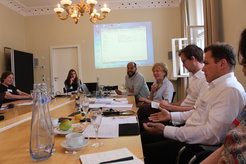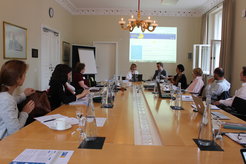Cultural and Religious Diversity under State Law across Europe (CUREDI)
Since 2018, the Department has been investing in what is meant to be a long-term project under the title ‘Cultural and Religious Diversity under State Law across Europe’, or CUREDI. CUREDI is a digital repository of cases - with a focus on case law analysis - that have to do with cultural and religious diversity and that show if, how, and to what extent diversity is granted legal recognition within the domestic legal systems of member states of the EU, UK, and Switzerland. CUREDI works with a network of scientific research teams that have demonstrated interest and expertise in the topics covered in the project.[i] Once the repository is sufficiently developed, the database will be made publicly accessible (in English) online.
An unparalleled initiative
The CUREDI project is unparalleled in Europe in its effort to identify, document, and offer in-depth analyses of legal reasoning on the manifold issues related to the growing social diversity throughout the EU (+ the UK and Switzerland). The cases show how domestic legal orders are gradually adapting to the reality of increasing cultural and religious diversity, as well as the demands for its recognition. The analyses focus on the arguments used in the rulings to justify the granting or, conversely, the rejection of claims to recognition of traditions, concepts, practices, beliefs, etc. Of particular relevance to the aims of CUREDI are references to empirical evidence, anthropological literature, or expert testimony used in judicial or administrative contexts to render a decision.
An initiative to meet the needs of research and legal practice
Prior research carried out by the Department, including a 2014 survey conducted among judges across Europe,[ii] as well as collaborative initiatives with the European Network of Councils for the Judiciary (ENCJ) and the European Judicial Training Network (EJTN), have highlighted the need for a comprehensive platform that offers rigorously researched information on how increasing cultural and religious diversity is addressed under state law in Europe.
In an increasingly diverse European context, with distinct socio-cultural communities, authorities - in particular judicial bodies - are required to take account of institutions, traditions, concepts, practices, beliefs, and sensibilities they may not be wholly familiar with. Their challenge lies in finding a sustainable balance between two competing considerations: (i) applying binding state law and (ii) accommodating claims for the recognition of cultural and religious diversity. This search for the right balance is more than an intellectual or academic challenge. Ever more frequently, it is also of great practical significance for a wide range of social actors and stakeholders, both within and outside of legal proceedings.
The project does not rely on pre-set definitions of culture or religion; instead, the aim is to study, document, and compare the various ways terms such as ‘culture’, ‘religion’, ‘tradition’, ‘worldview’, etc., are understood in legal reasoning. In highly sensitive, and therefore often much debated, societal and institutional conflicts of interest, the meaning of such terms is at times subject to radical reappraisals. CUREDI explores how different jurisdictions face similar or comparable conflicts without prioritizing any specific conception of culture or religion over another.
An interdisciplinary endeavour
A distinctive feature of CUREDI is its interdisciplinary nature: whenever relevant and to the extent possible, the analyses incorporate input from, in particular, social and cultural anthropology, a discipline that offers unique insights into cultural diversity. Anthropology contributes to the project in three distinct but complementary ways: first, an extensive bibliography is provided, offering the reader a selection of ethnographic works on a variety of topics relevant to the case law. The bibliography follows the same selection criteria as those used to select the court decisions to be analysed, so as to cover the same topics. As far as possible, references to the ethnographic literature are also included in the case entries to give readers a more detailed understanding of the sources and fresh perspectives on the issue in question. Lastly, the plan is to systematically invite social and cultural anthropologists to participate and offer their insights at each of the thematic meetings to be held under the aegis of the project, in order to enable an open-ended exchange between legal scholars and anthropologists. Anthropologists will also be invited to contribute to all publications to come out of the work of the project.
Three ways to impact the legal approach to diversity
In the long run, we see three ways for CUREDI to impact, both directly and indirectly, the legal approach to diversity across Europe.
First, the database provides unparalleled comparative insights into the increasing demands that cultural and religious diversity makes on governments, legislatures, and the judiciary in contemporary European societies as well as the various ways these demands are handled. European scholars, judges, legal practitioners, policymakers, and citizens regularly grapple with the question of how they are to accommodate diversity. By diligently analysing daily legal practice, CUREDI offers an accurate picture of how cultural and religious diversity impacts law in the fields of both public and private law. In the long run the ambition is that the online platform will contribute to research and comparative studies and foster a better understanding of different models for resolving conflicts revolving around diversity in law and the question of how to accommodate it.
Second, CUREDI does not propose standardized, ready-made solutions to deal with cultural and religious diversity. Instead, it makes available in a systematized way various types of materials dealing with real-life legal disputes involving religious and cultural diversity that researchers, legal practitioners, judges, and policymakers can draw inspiration from.
Third, CUREDI's long-term aim is to enhance the knowledge needed for a nuanced assessment of the impact of religious and cultural diversity on domestic legal systems in Europe. It is only by bringing together a critical mass of illustrations that one can make a proper assessment of this impact.
Project development: setting up a staff charged with the scientific coordination and expanding the academic network
Its ambitious goals render CUREDI a long-term project that consists of various stages.
In late 2017, the Department hired two full-time researchers, initially for a period of three years. Eugenia Relaño Pastor was tasked with the overall coordination of the exploratory stage of the project: instructing the contributors and correspondents and ensuring that the information they are asked to provide (i.e., published cases/laws, the status of cases in progress, and summaries of unpublished cases) is presented in the prescribed format. Rodrigo Céspedes was the first scholar hired to launch the systematic collection of data on a particular topic, commenting on several dozen cases related to issues of education. In December 2019, Jonathan Bernaerts joined the coordination team. Christoph Korb came on board in September 2019 to develop a platform that allows all partners to circulate information, exchange views, and comment on the case analyses. In the long run, the platform will contain all the relevant information for the database. The editing of the texts drafted by the contributors and the correspondents is in the hands of Sajjad Safaei, who is familiar with both the legal language and the anthropological literature. In March 2021 Doreen Hofmann joined CUREDI to assist with the scientific coordination. As of April 2021, an extended coordination team took office. Its members include: Jonathan Bernaerts, Katia Bianchini, Marie-Claire Foblets, Adriaan Overbeeke, Eugenia Relaño Pastor and Jinske Verhellen.

As of 2019, several members of the Department have also started contributing to the CUREDI project, each of them bringing their own expertise. These are, in alphabetical order, Jonathan Bernaerts, Katia Bianchini, Rodrigo Céspedes, Jeanise Dalli, Michelle Flynn, Alice Margaria, Mariana Monteiro de Matos, Maria Nikolova, Stefano Osella, Eugenia Relaño Pastor, and Federica Sona.
As of 2020, partners from across Europe have joined the project, including legal practitioners (judges in particular) and national correspondents for each country covered by the database.
The countries (in alphabetical order) and their respective correspondents are as follows: Belgium (Jinske Verhellen); Denmark (Lisbet Christoffersen); Finland (Sanna Mustasaari); Germany (Michael Germann, Imen Gallala-Arndt, and Mareike Schmidt); Italy (Davide Strazzari); the Netherlands (Susan Rutten); Spain (Ana Quinones); Sweden (Maarit Jänterä-Jareborg); and Switzerland (René Pahud de Mortanges).

A number of thematic experts have also been invited to contribute to the project: Katayoun Alidadi, expert on freedom of religion in the workplace; Adriaan Overbeeke, expert on relations between religions and the state, as well as freedom of religion and education; Silvia Tellenbach, criminal law expert; Anna Sledzinska-Simon, expert on minority protection; Mark Emerton, expert on freedom of religion in the workplace; Joseph Marko, Kerstin Wonisch and Sergiu Constantin, experts on minority protection. They are in charge of selecting cases that fall within the realm of their expertise and, in their view, deserve analysis and commentary. They will also regularly provide summaries of the pertinent legal developments in their respective countries.
CUREDI also welcomes visiting fellows who contribute to the CURED project during their stay at the Institute in Halle. Thus far, we have hosted Hanna Vasilevich and Kyril Kascian from the European Centre for Minority Issues, who collected cases revolving around accommodation of minority claims from the Czech Republic, Slovakia, and the Baltic Republics; Burim Ramaj (University of Fribourg); and in winter 2020, Alexander Ganepola (Eurac Research).
In late 2020, the CUREDI Editorial Board was set up. It is composed of prominent scholars who are authorities on the themes addressed in the project. The Board offers its assistance in three ways: by keeping track of relevant cases within their field of expertise; by assisting with the reviewing of the case synopses and analyses (templates); and by providing advice on the overall development of the project. Some members of the Board are also involved in other aspects of CUREDI, for instance as national correspondents or experts on certain themes. Currently, the members of the Editorial Board are: Lisbet Christoffersen, Mark Emerton, Silvio Ferrari, Michael Germann, Adriaan Overbeeke, Mareike Schmidt, Silvia Tellenbach and Jinske Verhellen. The Editorial Board also includes the members of the coordination team.
CUREDI is still in its early phases, but there is every reason to believe that we are well on our way to establishing a project that will, in the not too distant future, truly reflect the diversity of Europe.
[i] We acknowledge the existence of several databases that address topics and issues that are also of relevance for the purposes of the CUREDI initiative, notably the Global Citizenship Observatory (previously EUDO Citizenship; see https://globalcit.eu); EUREL (Sociological and legal data on religions in Europe and beyond; see http://www.eurel.info/?lang=en); Strasbourg Consortium for the Freedom of Conscience and Religion at the European Court of Human Rights (https://www.strasbourgconsortium.org/); and EURO-EXPERT (database on cultural expertise; see https://culturalexpertise.net/cultexp/), to name just a few. It goes without saying that CUREDI will provide the necessary cross-references.
[ii] See L. Vetters & M.-C. Foblets, “Culture all Around? Contextualizing Anthropological Expertise in European Courtrooms” (2016) 12 (3) International Journal of Law in Context 272–292.

